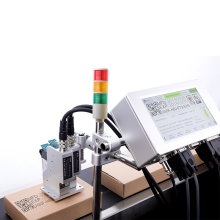Inkjet printers were developed after dot matrix printers, using non-attack working methods. The more prominent advantages include small size, simple and convenient operation, low printing noise, and can print pictures comparable to photos when using special paper. After several years of training, the technology of inkjet printers has made great progress. I think that in 1995, a color inkjet printer of more than one thousand yuan was enough to meet all the needs of ordinary families. Even for users who have high requirements for picture quality like photographers, they can reach more than two thousand to three thousand.
Inkjet printers can be divided into piezoelectric inkjet technology and thermal inkjet technology according to the working mode of the print head. According to the nature of inkjet materials, they can be divided into water-based materials, solid inks and liquid inks. The following Inkjet Label Printer Supplier will explain separately.
Inkjet Printer
Piezoelectric inkjet technology is to place many small piezoelectric ceramics near the nozzle of the inkjet printer's print head, and use the principle that it will deform under the action of voltage, and apply voltage to it in a timely manner. The piezoelectric ceramics then expand and contract to eject the ink in the nozzle, forming a pattern on the surface of the output medium.
The cost of inkjet print heads made with piezoelectric inkjet technology is relatively high. Therefore, in order to reduce the user's cost of use, the print head and the ink cartridge are generally made into a separate structure, and there is no need to replace the print head when replacing the ink. This technology was originally created by Epson, because the print head has a reasonable structure and can effectively adjust the size and use of ink droplets by controlling the voltage, so as to obtain higher printing accuracy and printing results. It has a strong ability to control ink droplets and is easy to achieve high-precision printing. The disadvantages are that if the nozzle is blocked during use, the cost of dredging or replacement is relatively high and difficult to operate, which may cause damage to the entire printer.
Thermal inkjet technology is to let the ink pass through a thin nozzle, under the action of a strong electric field, a part of the ink in the nozzle pipe is vaporized to form a bubble, and the ink at the nozzle is ejected to the surface of the output medium to form a pattern or character. So this kind of inkjet printer is sometimes called a bubble printer. The nozzle made with this technology is relatively mature and low in cost, but since the electrodes in the nozzle are always affected by electrolysis and corrosion, it will have a lot of impact on the service life.
Our company has Inkjet Printer on sale, welcome to contact us.

评论
发表评论